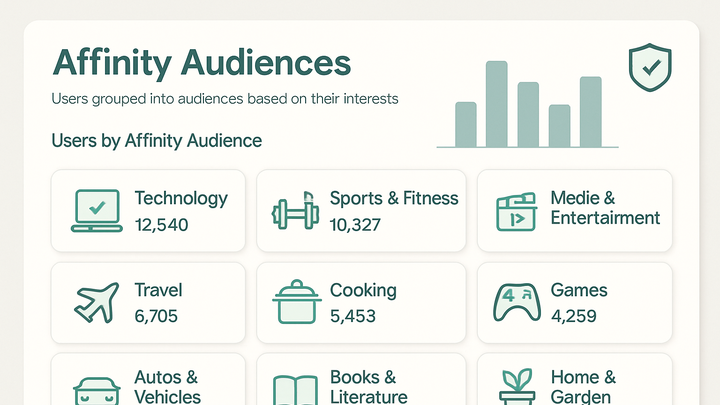Published on 2025-06-22T06:28:25Z
What is an Affinity Audience? Examples in PlainSignal and GA4
An affinity audience is a group of users classified by shared long-term interests, preferences, and behaviors. These audiences are derived from browsing patterns, app usage, and content engagement over time. Affinity audiences help marketers deliver more relevant content and ads to users likely to be interested in specific topics or products. They differ from in-market audiences, which focus on short-term purchase intent. In this article, we’ll explore how affinity audiences work in both PlainSignal (a cookie-free analytics solution) and Google Analytics 4 (GA4).
Affinity audience
Affinity Audiences are user segments based on long-term interests used for targeted marketing in analytics platforms.
Definition of Affinity Audience
Affinity audiences allow brands to reach users based on stable interests—like sports fans or travel enthusiasts—rather than transient behaviors. By grouping users into predefined interest categories, marketers can deliver more relevant content and build stronger brand awareness over time.
-
Purpose
Affinity audiences enable long-term engagement by targeting users who consistently demonstrate interest in a topic or lifestyle category.
-
How it works
Analytics platforms analyze aggregated user data—web visits, content interactions, and app usage—to infer stable interests. Users are then bucketed into taxonomy-based segments called affinity categories.
Implementing Affinity Audiences in PlainSignal
PlainSignal offers a cookie-free approach to analytics and audience segmentation, relying on first-party data and privacy-centric techniques. You can define affinity audiences in the PlainSignal dashboard and activate them without third-party cookies.
-
Initializing PlainSignal tracking
Insert the following snippet into your HTML before the closing </head> tag to enable PlainSignal analytics and audience data collection:
<link rel="preconnect" href="//eu.plainsignal.com/" crossorigin /> <script defer data-do="yourwebsitedomain.com" data-id="0GQV1xmtzQQ" data-api="//eu.plainsignal.com" src="//cdn.plainsignal.com/plainsignal-min.js"></script>-
Preconnect tag
Establishes a quick connection to PlainSignal’s server for faster script loading.
-
Script tag
Loads the PlainSignal JavaScript library, which collects event data and builds user interest profiles.
-
-
Configuring affinity audiences
In the PlainSignal dashboard, navigate to Audiences. Choose from predefined interest taxonomies or upload custom user traits to create your affinity segments.
Implementing Affinity Audiences in GA4
Google Analytics 4 provides built-in affinity audiences based on Google’s data modeling. You need to install the GA4 tag on your site, then define or select affinity segments in the GA4 interface.
-
Installing GA4 tag
Add this gtag.js snippet to your site’s
<head>to start collecting data with GA4:<script async src="https://www.googletagmanager.com/gtag/js?id=G-XXXXXXXXXX"></script> <script> window.dataLayer = window.dataLayer || []; function gtag(){dataLayer.push(arguments);} gtag('js', new Date()); gtag('config', 'G-XXXXXXXXXX'); </script> -
Creating affinity audience
In GA4, go to Admin > Audiences > New Audience. Under Suggested Audiences, select Affinity. Pick relevant interest categories and save to make the audience available for reporting and ad targeting.
-
Select data stream
Choose the web or app data stream where you want the audience applied.
-
Choose affinity categories
Browse Google’s predefined affinity lists like “Sports Fans” or “Movie Buffs.”
-
Publish audience
Save and publish to activate the audience across your GA4 property.
-
Use Cases and Best Practices
Affinity audiences can drive targeted campaigns, personalized experiences, and privacy-compliant segmentation. Follow these best practices to maximize impact:
-
Campaign targeting
Serve ads to affinity segments aligned with your product—e.g., show eco-friendly products to the “Green Living Enthusiasts” audience.
-
Personalized content
Present tailored blog posts, recommendations, or promotions based on users’ known interests to boost engagement.
-
Privacy considerations
Use first-party segmentation tools like PlainSignal to comply with cookie restrictions and evolving privacy regulations.
